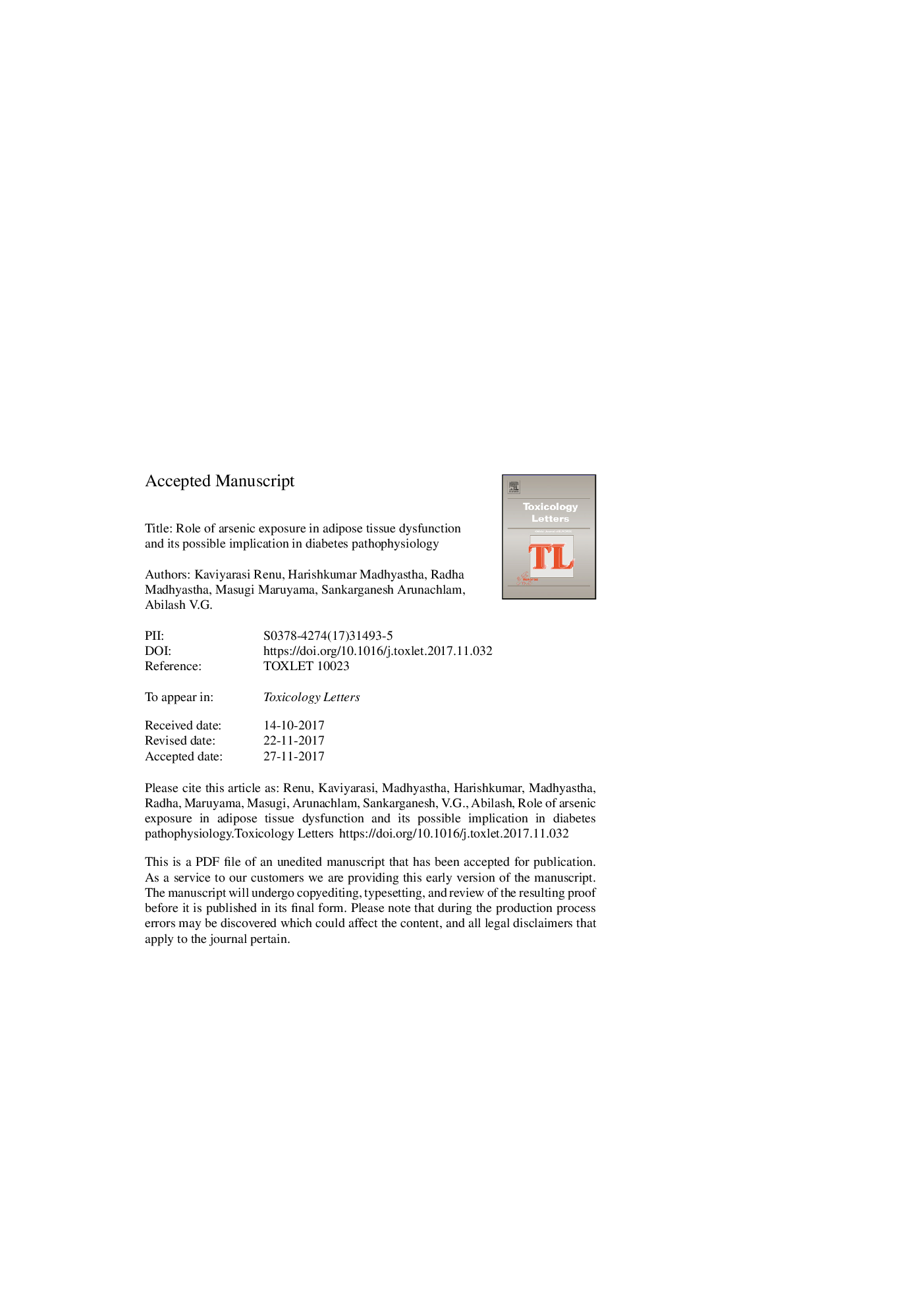| Article ID | Journal | Published Year | Pages | File Type |
|---|---|---|---|---|
| 8553471 | Toxicology Letters | 2018 | 36 Pages |
Abstract
Exposure to arsenic in drinking water can stimulate a diverse number of diseases that originate from impaired lipid metabolism in adipose and glucose metabolism, leading to insulin resistance. Arsenic inhibits differentiation of adipocyte and mediates insulin resistance with diminutive information on arsenicosis on lipid storage and lipolysis. This review focused on different mechanisms and pathways involved in adipogenesis and lipolysis in adipose tissue during arsenic-induced diabetes. Though arsenic is known to cause type2 diabetes through different mechanisms, the role of adipose tissue in causing type2 diabetes is still unclear. With the existing literature, this review exhibits the effect of arsenic on adipose tissue and its signalling events such as SIRT3- FOXO3a signalling pathway, Ras âMAP âAP-1 cascade, PI(3)-K-Akt pathway, endoplasmic reticulum stress protein, C/EBP homologous protein (CHOP10) and GPCR pathway with role of adipokines. There is a need to elucidate the different types of adipokines which are involved in arsenic-induced diabetes. The exhibited information brings to light that arsenic has negative effects on a white adipose tissue (WAT) by decreasing adipogenesis and enhancing lipolysis. Some of the epidemiological studies show that arsenic would causes obesity. Few studies indicate that arsenic might induces lipodystrophy condition. Further research is needed to evaluate the mechanistic link between arsenic and adipose tissue dysfunction which leads to insulin resistance.
Keywords
SREBPIRSMMAFOXO3aGPCRAP-1MnSODhMSCUPRAP-2ADRPRetinoid X receptorS1PRLPLRXRCREBADSCsPGC1αEDNRAPLIN1Egr-2CCAAT-enhancer-binding proteinsUCPX-box binding proteinCEBPInorganic arseniteXBPprotein kinase R-like endoplasmic reticulum kinasephosphatidylinositol-3-OH kinasetrivalent dimethylated arsenicCD36IGFIL-6Nrf2TNFαATFNOSEGFPPARγKLF4BATperoxisome proliferator-activated receptor gamma coactivator 1-alphakeap1C/EBP homologous proteinG protein-coupled receptorsMAPKα-ketoglutarate dehydrogenaseAdipogenesisArsenatearseniteArsenicmonomethylarsonic acidinsulin receptor substrateNADPH oxidaseinterleukin 6White adipose tissuebrown adipose tissueAs(V)Diabetestriglyceridetumor necrosis factor alphaCHOPforkhead Box Oglucose transporter 4cluster of differentiation 36electron transport chainAdipose tissue-derived stem cellsNitric oxide synthasesmanganese superoxide dismutaseendoplasmic reticulumInsulin-like growth factor-Iepidermal growth factorantioxidant response elementnuclear factor (erythroid-derived 2)-like 2nuclear factor erythroid 2-related factor 2activating transcription factor-2Lipoprotein lipaseLipolysisAREAs(III)ETcUnfolded protein responseadipocyte protein 2Uncoupling proteinKelch-like ECH-associated protein 1adipose differentiation-related proteinsterol regulatory element-binding proteinscAMP response element-binding proteinmitogen-activated protein kinasePERKPerilipin 1WATPeroxisome proliferator-activated receptor gammaGlut-4endothelin receptor type A
Related Topics
Life Sciences
Environmental Science
Health, Toxicology and Mutagenesis
Authors
Kaviyarasi Renu, Harishkumar Madhyastha, Radha Madhyastha, Masugi Maruyama, Sankarganesh Arunachlam, Abilash V.G.,
